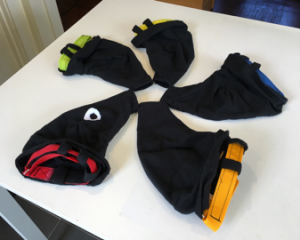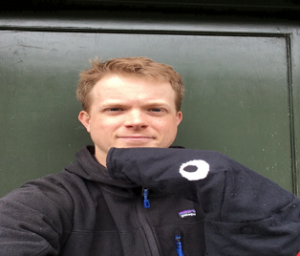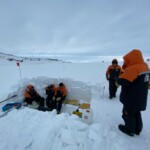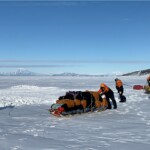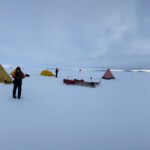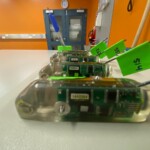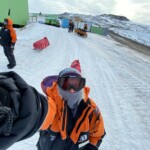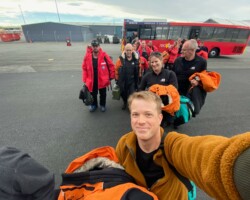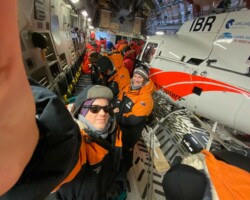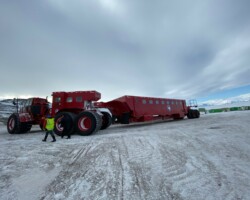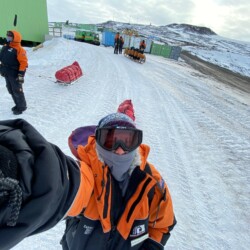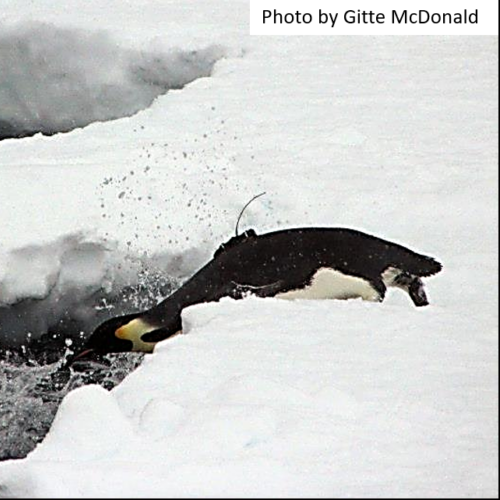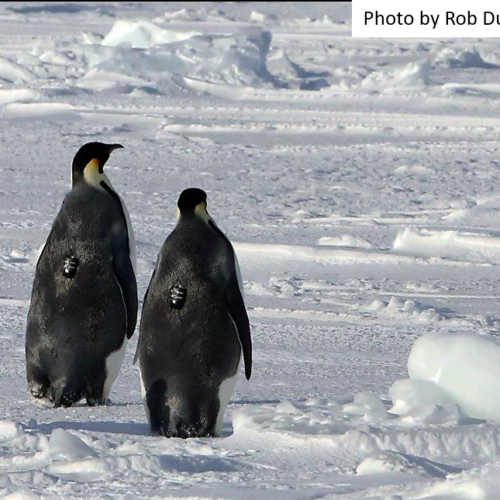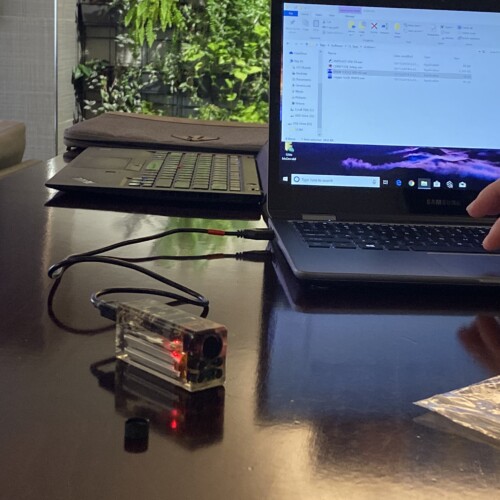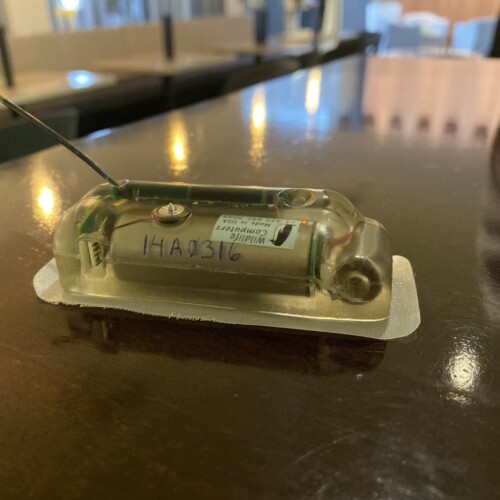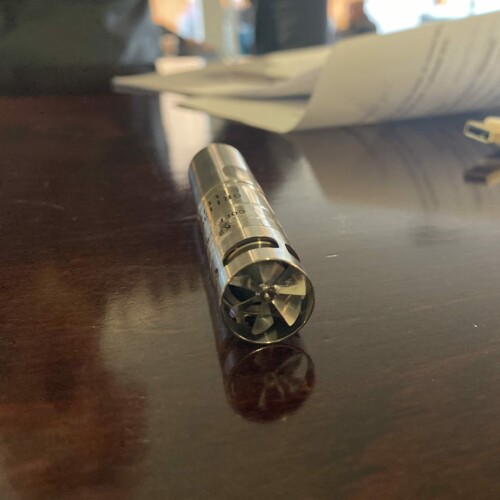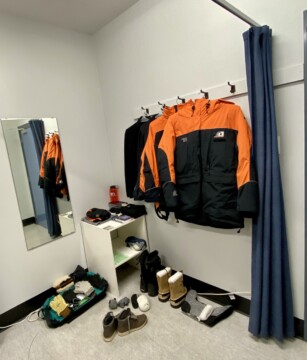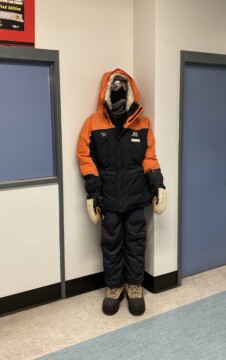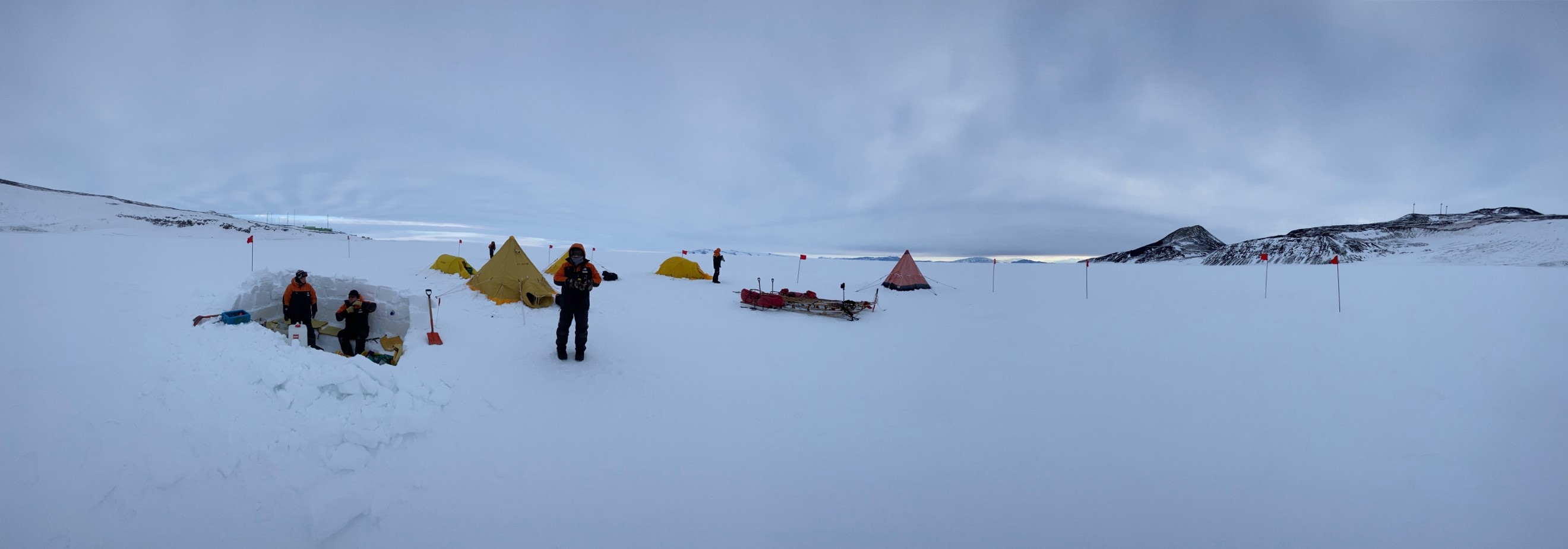
Hidden Lives of Emperor Penguins
Background
Despite being the first emperor penguin colony discovered in 1902 during Scott’s Discovery Expedition(1901–1904) little is known about that at-sea behavior of emperor penguins from Cape Crozier. The first science expedition to study them was in 1911, when a small group from Scott’s Terra Nova Expedition team made the perilous journey to the colony in the winter to collect eggs. Since this early study, most research at the Crozier colony has involved counting the birds to monitor the population. This fall we will head to Cape Crozier to study the foraging ecology of one of the southernmost emperor penguin colonies. We hope that you will follow along on our adventure as we prepare for the field work, travel to Antarctica to study the birds, and analyze the data. We look forward to sharing with you new discoveries about the ecology of the emperors of the ice.
This is an internationally collaborative project with logistic support provided by Antarctica New Zealand and primary funding provided to NIWA as part of the project “Ross Sea Research and Monitoring Programme: is the world’s largest MPA effective” (New Zealand Ministry of Business, Innovation and Employment: 2017-2022). Additional funding has been awarded to Birgitte McDonald by the National Geographic Society (Grant # NGS-50069R-18) and SeaWorld Conservation Fund.
Project Objectives
As abundant year-round predators, emperor penguins have a significant top down effect on prey in the Antarctic Ecosystem. It is vital to obtain information on their foraging ecology to understand their role in the ecosystem and how this may change with environmental change. Our collaborative project will investigate the foraging ecology and habitat use of Ross Sea emperor penguins during late chick rearing, an energetically challenging phase of the life cycle when parents must meet the energetic demands of their rapidly growing chicks. Specifically, we will use a combination of video cameras, fine-scale movement data loggers, and stable isotope analysis to: 1) Determine the activity budget of emperor penguins and estimate energy expenditure during a foraging trip, 2) Identify key prey of emperor penguins and identify stereotypical behaviors associated with foraging on different prey types. 3)Combine the energy estimations with the diet and foraging success data, to assess if emperor penguins are foraging optimally, and 4) Integrate penguin behavioral data with environmental data to identify which environmental features are indicative of habitat preference and associated with energy gain. This study fills important knowledge gaps on energy balance, diet, foraging strategy, and habitat use of emperor penguins.
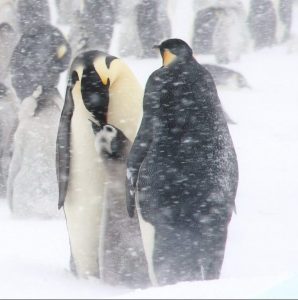
Wheels on Ice!
The Emperor Penguin Team successfully departed Christchurch on Monday October 21st and arrived at Scott Base, Ross Island, Antarctica . Our flight on the C-17 was an easy 5 hours and the views from the fixed window were marvelous. As we approached Antarctica the plane started to get colder forcing all of the passengers to put on our extreme weather gear. Landing on ice was smoother than I had anticipated especially considering the great weight of the plane and contents including a full size helicopter, packed cargo and passengers. The C-17 landed and the passengers excitedly grabbed their things and started to exit the plane. Since the plane did not have many windows in the seating area our steps through the plane door were our first view of Antarctica.
For those of us who had never been to Antarctica before the views were quite literally breathtaking as the dry cold air filled our lungs. For others who have been here before, I can imagine this never gets old. In the distance we could see Mt. Erebus and Mt Discovery. We had a short walk on the ice to the large transport vehicle called a Kress. We boarded the Kress and after a safety briefing all the passengers buckled in and we were a short 30-minute drive to Scott Base. Once at Scott Base we received a tour of the well-maintained facilities and met with the staff to plan our busy week of preparations including our Antarctic Field Training (AFT) that involved an overnight stay on the ice.

AFT Overnight Oct. 22nd
As part of our field training we learned to use our primus stoves, set up tents, and safety procedures for working in cold and unpredictable environments. Following our training we then prepared our gear for our overnight stay on the ice shelf. We loaded all our gear on sleds and pulled them by hand for a half hour. We learned to drill ice cores and assess the stability of ice which involved first digging a hole in the snow about a meter and a half deep. Once we reached the ice-surface we used a Kovac-drill to burrow through the ice. We determined that the ice was stable enough to set up camp as it fell within the 70cm+ regulated thickness. Following the assessment, we proceeded to set up three Scott Tents and two mountaineering tents rated to withstand the worst weather conditions (Grade 1). Emperor penguin team member Markus created a much-appreciated wind break and cooking area for the crew. With wind chill the temperature dropped as low as -36 degrees Celsius. We set up our tents, enjoyed a nice dehydrated meal, filled our water bottles with hot water, and headed to our beds. Exhaustion made sleeping very easy after this long day.

Recon Flight Success Oct 23rd
Gitte and Markus flew out to Cape Crozier today via helicopter to plan out our field camp location and locate the penguin colony. Good news the emperor penguin colony was located and estimated numbers are around 1,500 individuals. They were also able to locate a secure spot perfect for our camp. We are scheduled to fly out and set up camp on Monday October 28th.
Expedition Gear Preparation
For the last four days we have been busy gathering, weighing, putting together 5 helicopter loads full of essential gear we require while at remote camping at Cape Crozier for 3-4 weeks. Gear includes food for 5 weeks, 9 tents, generator, cutlery, sleeping gear and everything that we may require for daily use. It has been very busy and exciting packing all of our gear as we carefully plan what we will need for the next four weeks.
We also have been field testing our data-logging tags in the cold conditions and everything is looking good and ready for Monday.
Diving Deeper
Emperor penguins are the largest species of marine bird, and perhaps because of their size, they fast longer, dive deeper, and endure harsher conditions than any other avian species. As a top predator in the Antarctic ecosystem, they have a significant top-down effect on prey targeted during long, deep breath-hold dives. It is therefore essential to understand emperor penguin habitat use, diving capabilities, food habits, and behavioral flexibility in order to interpret their role in the food web and their ability to adapt to environmental change. However, studying marine vertebrates has its challenges, as we cannot visually observe their underwater behavior.
During late chick-rearing emperor penguins, a colonial breeding seabird, alternate 5-20+ day foraging trips with short visits to the colony to feed their chicks. During these foraging trips they may travel over 100 kms from the colony and dive to depths exceeding 500 meters for over 30 minutes(Kooyman et al. 1992; Wienecke et al. 2007; K. Sato et al. 2011; Goetz et al. 2018)! Incredible!!
Although researchers may not be able follow penguins on their extreme journeys, engineered data-logging tools (tags) allow us to track animals at fine-scale resolutions. This season we are deploying tags on 20 adult emperor penguins as they head to sea to forage. Four tag types of variable configurations will be used to study at-sea behavior. Some of the data these tags collect include dive depth, acceleration, GPS location, and video allowing us to determine where they go, when they are foraging, and what they are eating. Additionally, the tags collect data telling us about the environment the penguins are using such as temperature and light level. With these data loggers we hope to document many firsts. This will be the first study to document the foraging behavior of penguins from Cape Crozier, one of the southernmost colonies. Additionally, we are excited to visually document the foraging behavior of emperor penguins for the first time using a miniature video-logger developed by Little Leonardo Corporation in Tokyo. We will learn more about what they are eating and how they are catching their prey.
To further our understanding of the hidden lives of emperor penguins we must go where few have gone before.
Dive On,
Emperor Penguin Field Crew
Fingers crossed for a Friday departure to Scott Base
The Cape Crozier Penguin Team arrived safe and sound in Christchurch New Zealand where we are waiting for our flight to Scott Base, Antarctica. We were scheduled to fly today, however we have been delayed due to a cracked windshield on the plane. Currently our flight has been postponed until Friday Oct. 18th as we are waiting for a new windshield to arrive from the USA.
In the meantime, the penguin team has been busy planning our field logistics so that we may hit the ground running on Friday. Today we are setting up our data-logging tags that will measure the GPS location, acceleration and fine-scale foraging behaviors of chick-rearing emperor penguins. Stay tuned for more information about the tags we will be using this season.
Proactively in standby,
Emperor Penguin Field Crew
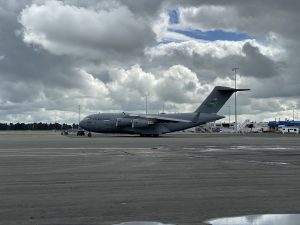
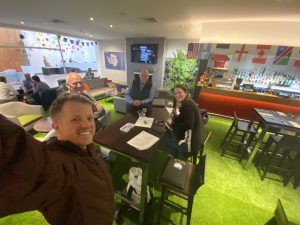
Emperor Penguin Crew Lands In Christchurch New Zealand
The Penguin Team has landed in New Zealand after a 12 hour long flight from San Francisco to Aukland and a quick (1.5 hr) connecting flight to Christchurch. While in Christchurch we visited the International Antarctic Center where we were issued our clothing field gear for this season. A New Zealand rep "Lou" helped us out with our clothing selections that include warm marino wool base layers, 6 pairs of gloves, 4 hats, two pair of boots, fleece pants and down jackets, and incredibly warm survival gear. We are ready for our trip scheduled to leave at 9am on Wednesday October 19th.
Warm and ready for the Ice,
Emperor Penguin Field Crew
Field Season Preparations: 08/30/19
Shipping our field gear to Antarctica
Although our field season is still 6 weeks away, preparations are in full gear. This last month we have been busy ordering research supplies. We somehow managed to fit all the gear into 4 boxes that are now waiting to be shipped to Antarctica. One thing that is a little different, is we have to separate gear into items that can and can not be frozen so when they get to Antarctica they are stored properly for our arrival. Students in the Lab are happy that we are sending this gear out so that they may have a little more room.
Signed Sealed and Awaiting Delivery To Antarctica,
Emperor Penguin Field Crew
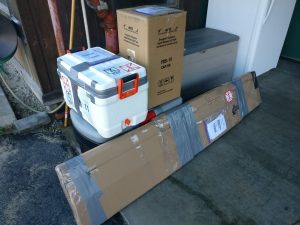

Antarctica Preparations II: 09/15/2019
Building a cost effective time-depth recorder to track fine-scale penguin Foraging Behavior
We developed our own animal-worn datalogging tags that measure the fine-scale diving behavior of marine predators. Datalogging tags are an integral tool to studying marine predator diving behavior because they allows us to document animals where we are unable to follow them on their foraging trips. These tags measure an animal's precise location, fine-scale movement and acceleration, temperature of the water, and the depth the animal dive (down to 1000 meters). These tags will be used to document emperor penguin diving behavior and track their movements while they forage at-sea. Emperor penguins are known to dive to great depths (564 meters) and for long durations (>27 minutes) in search of prey. Once the penguins return to the colony to feed their chick we will remove the tag and download the data from their journeys.
Datalogging tags can be purchased however they are very expensive and can be a barrier for many students and researchers. In collaboration with Dr. Birgitte McDonald, Katie Harrington, James Fahlbusch, and Parker Forman we developed a cost-effective and open source datalogging tag that is one third of the cost of current tags on the market. This open source datalogging technology will put high resolution, low cost, and customizable tags in the hands of more researchers.
Dive On,
Emperor Penguin Field Crew
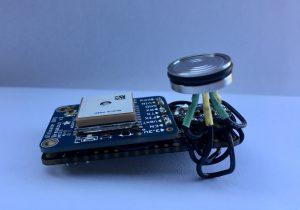
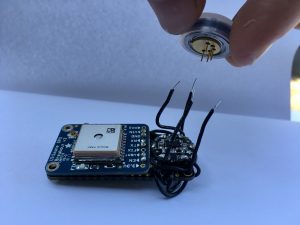
Antarctica Preparations I: 08/10/2019
Penguin goods & safe handling procedures
Avian ecologist have always used hoods as a method to cover the heads of the bird species they study. These hoods cover the eyes of the animal and reduce their stress while researchers take measurements such as weight, wing and bill length, and blood samples. Birds can be very sensitive to sudden movements, noises and changes in light and hoods are used to reduce these sensitivities by covering their eyes and ears. Once the hoods are placed over the bird’s head they quickly become more calm. Placing a hood on the bird creates a safe and comfortable environment for the subject while biological measurements are taken.
In preparation for our upcoming trip to Antarctica (October 2019) we have sewn our very own emperor penguin hoods. Each of these hoods has been hand made out of durable, soft, very thin and breathable dark fabric. These penguin hoods have a comfortable neck strap that allows us to adjust the fit of the hood per the penguin’s liking. There is an opening at the tip of the hoods that allows for the bill of the penguin to fit through and increases airflow for ease of breathing. The hoods are placed on the heads of the penguin similar to what it would look like if you placed a sock puppet on your hand (as displayed by Parker in the adjacent image). An eye cutout was placed on one of the hoods to display the approximate location of where the penguin eye would be located under the hood.
We are very excited to share our preparation processes as we get our gear ready for our trip to Antarctica. Stay tuned for upcoming posts on our penguin preparation: tag development, weight harness manufacturing, and more information on our upcoming trip.
Safety First,
Emperor Penguin Field Crew
